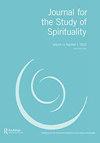Time, change and the study of spirituality
IF 0.8
0 RELIGION
引用次数: 0
Abstract
In the Western Hemisphere, we have just passed the Spring Equinox, so we have more daylight now than night as we move towards summertime. This transition is reflected in nature with its wonderful array of colour, sounds and activity. Spring is the season of new birth and beginnings, the time of evolution and change. In many religions and worldviews, Spring is associated with a time of hope and optimism. Hope and optimism are certainly welcome as many countries experience the effects of wars, natural disasters, the impact of climate change and financial hardship due to the fuel crisis and dreadful economic situation. Conversely, we have witnessed the compassionate response of so many people giving generously to support the relief efforts to help alleviate the impact and suffering caused by these devastating situations. On a recent visit to Cambridge I (WMc) noticed a small crowd had gathered at the corner of a street; they were all staring and studying something in a window. Being of the curious type I wondered what the commotion and attraction was and wandered over to look. To my amazement they were looking at what could be described as a golden disc with what appeared to be a grasshopper on the top. I later learned that this was the ‘Corpus Clock’, a significant landmark and attraction for tourists to the city. There is a good introduction provided on Corpus Christi College website which states ‘It was invented, designed and given to Corpus Christi College by Dr John C Taylor OBE FREng (m1959), who worked with local engineering company Huxley Bertram in constructing the Clock’. What does the Corpus Clock have to do with time and the study of spirituality? The passage of time is inextricably linked to spiritualty and our own mortality. The Corpus Clock has no chimes or bells, and just as we move from winter into spring often silently without fuss or punctuation, so we pass through the seasons of our lives. Each of us has a finite amount of time and the impact of time results in transition as we move through life and, if we are fortunate, experience the ageing process with its resultant holistic change. The juxtaposition is that, while we change with the effects of time, spirituality remains a constant in time, enduring and for some reflecting the changing trends, philosophies, worldviews, and challenges of that time.时间,变化和灵性研究
在西半球,我们刚刚度过春分,所以随着夏季的临近,我们现在的白天比晚上多。这种转变以其美妙的色彩、声音和活动方式反映在自然界中。春天是新生和开始的季节,是进化和变化的季节。在许多宗教和世界观中,春天与希望和乐观的时刻联系在一起。希望和乐观肯定是受欢迎的,因为许多国家都经历了战争、自然灾害、气候变化的影响以及燃料危机和可怕的经济形势造成的财政困难。相反,我们看到了如此多的人慷慨解囊,支持救援工作,以帮助减轻这些毁灭性局势造成的影响和痛苦。在最近访问剑桥时,我(WMc)注意到一小群人聚集在街角;他们都盯着窗户里的东西看。作为一个好奇的人,我想知道这是什么样的骚动和吸引力,于是走过去看了看。令我惊讶的是,他们看到了一个可以被描述为金色圆盘的东西,上面似乎有一只蚱蜢。后来我才知道,这就是“尸钟”,是这座城市的一个重要地标和景点。科珀斯克里斯蒂学院网站上有一个很好的介绍,上面写着“它是由John C Taylor OBE FREng博士(m1959)发明、设计并赠送给科珀斯克里斯蒂大学的,他与当地工程公司Huxley Bertram合作建造了时钟”。尸钟与时间和精神研究有什么关系?时间的流逝与精神和我们自身的死亡密不可分。尸钟没有编钟,就像我们从冬天进入春天一样,我们常常默默地度过生命中的各个季节,没有任何大惊小怪或标点符号。我们每个人都有有限的时间,时间的影响会导致我们在生活中的转变,如果幸运的话,还会经历衰老过程及其带来的整体变化。并列的是,虽然我们随着时间的影响而变化,但精神在时间中仍然是不变的,经久不衰,对一些人来说,它反映了当时不断变化的趋势、哲学、世界观和挑战。
本文章由计算机程序翻译,如有差异,请以英文原文为准。
求助全文
约1分钟内获得全文
求助全文
来源期刊

Journal for the Study of Spirituality
RELIGION-
CiteScore
2.50
自引率
7.10%
发文量
25
期刊介绍:
Journal for the Study of Spirituality is a peer-reviewed journal which creates a unique interdisciplinary, inter-professional and cross-cultural forum where researchers, scholars and others engaged in the study and practices of spirituality can share and debate the research, knowledge, wisdom and insight associated with spirituality and contemporary spirituality studies. The British Association for the Study of Spirituality (BASS) organises a biennial international conference and welcomes enquiries about membership from those interested in the study of spirituality in the UK and worldwide. The journal is concerned with what spirituality means, and how it is expressed, in individuals’ lives and communities and in professional practice settings; and with the impact and implications of spirituality in, and on, social policy, organizational practices and personal and professional development. The journal recognises that spirituality and spiritual values can be expressed and studied in secular contexts, including in scientific and professional practice settings, as well as within faith and wisdom traditions. Thus, Journal for the Study of Spirituality particularly welcomes contributions that: identify new agendas for research into spirituality within and across subject disciplines and professions; explore different epistemological and methodological approaches to the study of spirituality; introduce comparative perspectives and insights drawn from different cultures and/or professional practice settings; aim to apply and develop sustained reflection, investigation and critique in relation to spirituality and spiritual practices; critically examine the values and presuppositions underpinning different forms of spirituality and spiritual practices; incorporate different forms of writing and expressions of spirituality.
 求助内容:
求助内容: 应助结果提醒方式:
应助结果提醒方式:


